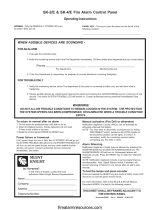
D
C
B
A
5
4
3
2
1
CPG #2561255 FIRELARM 2500 Operating Manual
i
Contents
Contents
1 Overview...............................................................................1-1
1.1 General description...................................................................................................................1-1
1.2 System features.........................................................................................................................1-1
1.3 Specifications ............................................................................................................................1-2
1.3.1 Electrical specifications............................................................................................................1-2
1.3.2 Housing ....................................................................................................................................1-2
1.3.3 Service use: NFPA-72 .............................................................................................................1-3
1.3.4 Listings and approvals .............................................................................................................1-3
2 Operation..............................................................................2-1
2.1 Touchpad....................................................................................................................................2-1
2.2 Visual indicators (LEDs) ...........................................................................................................2-2
2.3 Normal Standby Condition .......................................................................................................2-3
2.4 Silence and reset operation......................................................................................................2-3
2.4.1 Silencing a non-normal condition (buzzer or NAC)..................................................................2-3
2.4.2 Resetting an alarm condition ...................................................................................................2-3
2.4.3 Resetting a trouble condition ...................................................................................................2-3
2.5 Alarm, trouble, and supervisory conditions (by panel LED label) .......................................2-3
2.5.1 Ground fault .............................................................................................................................2-3
2.5.2 Annunciator trouble..................................................................................................................2-3
2.5.3 NAC trouble / silence ...............................................................................................................2-4
2.5.4 Supervisory trouble ..................................................................................................................2-4
2.5.5 Initiating zone trouble...............................................................................................................2-4
2.5.6 …..............................................................................................................................................2-4
2.5.7 Initiating circuit alarm ...............................................................................................................2-4
2.5.8 Auxiliary power output conditions ............................................................................................2-5
2.5.9 Battery power conditions..........................................................................................................2-5
2.5.10 AC power conditions ............................................................................................................2-5
2.5.11 System trouble......................................................................................................................2-5
2.5.12 Supervisory initiating device circuit ......................................................................................2-5
3 Installation............................................................................3-1
3.1 Safety message to installers ....................................................................................................3-1
3.2 NFPA and UL installation requirements..................................................................................3-1
3.2.1 Requirements for all installations .............................................................................................3-1
3.2.2 Requirements for Local Fire Alarm Systems ...........................................................................3-1
3.2.3 Requirements for Auxiliary Fire Alarm Systems ......................................................................3-1
3.2.4 Requirements for Remote Station Fire Alarm Systems ...........................................................3-1
3.2.5 Requirements for Central Station Fire Alarm Systems ............................................................3-2
3.3 Installing the cabinet (and optional bezel)..............................................................................3-2
3.4 Wiring..........................................................................................................................................3-3
3.5 Quick Reference Operating Instructions form .......................................................................3-3
3.6 Zonal Digital Alarm Communicator Transmitter (optional ZDACT)......................................3-3
3.7 Battery size requirements.........................................................................................................3-3
3.8 Notification Appliance Circuits Connections .........................................................................3-7
4 Configuration and Programming .......................................4-1
4.1 Selecting connected device options (DIP switches)..............................................................4-1





















